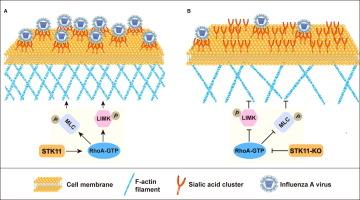全基因组CRISPR筛选鉴定STK11是对甲型流感病毒附着重要的唾液酸簇的关键调节因子
IF 13
1区 综合性期刊
Q1 MULTIDISCIPLINARY SCIENCES
引用次数: 0
摘要
猪流感病毒(SIV)是猪的一种高度传染性呼吸道病原体,给养猪业造成巨大的经济损失。重要的是,猪是多种甲型流感病毒(iav)的“混合容器”,通过重组促进了新型大流行毒株的出现,这代表了持续的全球公共卫生威胁。IAV复制在很大程度上依赖于宿主细胞机制,这强调了阐明病毒-宿主蛋白相互作用对于开发靶向抗病毒治疗的重要性。本研究旨在通过全基因组CRISPR筛选鉴定SIV复制所需的宿主基因,并阐明STK11调节病毒复制的机制。方法在新生猪气管(NPTr)细胞中进行猪基因组级CRISPR基因敲除(PigGeCKO)筛选,鉴定SIV复制所需的宿主基因。候选基因通过使用CRISPR/ cas9介导的基因编辑产生敲除细胞系进一步验证,然后评估它们对IAV复制的影响。通过Western blotting、共聚焦显微镜、透射电镜和受激发射损耗(STED)成像确定STK11调控的特定生命周期阶段及其在病毒附着中的机制作用。用STK11靶向siRNA处理BALB/c小鼠,在体内验证STK11敲低对IAV复制的影响,并通过生存分析、体重监测、肺病毒滴度定量、免疫荧光和组织病理学来评估结果。结果STK11在体外可促进不同IAV亚型的复制,敲低STK11可显著抑制SIV在体内的复制。在机制上,STK11缺失通过改变唾液酸簇的组织来损害病毒附着,通过抑制RhoA信号通路减少细胞内肌动蛋白应激纤维来介导。结论我们发现STK11是一种新的IAV附着调节因子,并阐明了其促进病毒进入的机制。这些发现突出了STK11作为抗IAV感染的理想抗病毒靶点的潜力。本文章由计算机程序翻译,如有差异,请以英文原文为准。

Genome-wide CRISPR screen identifies STK11 as a critical regulator of sialic acid clusters important for influenza A virus attachment
Introduction
Swine influenza virus (SIV) is a highly contagious respiratory pathogen in pigs that causes substantial economic losses in the pig industry. Importantly, pigs act as “mixing vessels” for diverse influenza A viruses (IAVs), facilitating the emergence of novel pandemic strains through reassortment, which represents a continuous global public health threat. IAV replication relies heavily on host cellular machinery, underscoring the importance of elucidating virus-host protein interactions for the development of targeted antiviral therapeutics.Objectives
This study aims to identify host genes required for SIV replication via a genome-wide CRISPR screen and elucidate the mechanism by which STK11 modulates viral replication.Methods
A pig genome-scale CRISPR knockout (PigGeCKO) screen was performed in newborn pig trachea (NPTr) cells to identify host genes required for SIV replication. Candidate genes were further validated by generating knockout cell lines using CRISPR/Cas9-mediated gene editing, followed by assessing their impact on IAV replication. The specific lifecycle stage regulated by STK11 and its mechanistic role in viral attachment were determined via Western blotting, confocal microscopy, transmission electron microscopy, and stimulated emission depletion (STED) imaging. In vivo validation of STK11 knockdown effects on IAV replication was conducted in BALB/c mice treated with STK11-targeting siRNA, with outcomes evaluated by survival analysis, body weight monitoring, lung viral titers quantification, immunofluorescence, and histopathology.Results
STK11 promotes replication of different IAV subtypes in vitro, and STK11 knockdown significantly suppresses SIV replication in vivo. Mechanistically, STK11 depletion impairs viral attachment by altering the organization of sialic acid clusters, mediated through reduced intracellular actin stress fibers via inhibition of RhoA signaling pathway.Conclusion
We identify STK11 as a novel regulator of IAV attachment and elucidate its mechanistic role in facilitating viral entry. These findings highlight the potential of STK11 to serve as an ideal antiviral target against IAV infection.求助全文
通过发布文献求助,成功后即可免费获取论文全文。
去求助
来源期刊

Journal of Advanced Research
Multidisciplinary-Multidisciplinary
CiteScore
21.60
自引率
0.90%
发文量
280
审稿时长
12 weeks
期刊介绍:
Journal of Advanced Research (J. Adv. Res.) is an applied/natural sciences, peer-reviewed journal that focuses on interdisciplinary research. The journal aims to contribute to applied research and knowledge worldwide through the publication of original and high-quality research articles in the fields of Medicine, Pharmaceutical Sciences, Dentistry, Physical Therapy, Veterinary Medicine, and Basic and Biological Sciences.
The following abstracting and indexing services cover the Journal of Advanced Research: PubMed/Medline, Essential Science Indicators, Web of Science, Scopus, PubMed Central, PubMed, Science Citation Index Expanded, Directory of Open Access Journals (DOAJ), and INSPEC.
 求助内容:
求助内容: 应助结果提醒方式:
应助结果提醒方式:


